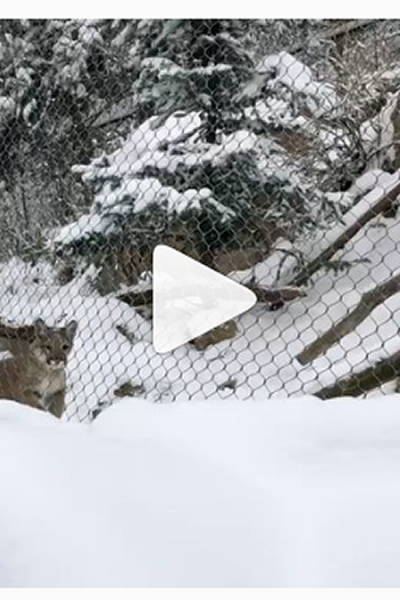



“When will the new hippo and penguin exhibit open?” has been a common question we’ve received both in-person and online for the past several months. Our President & CEO, Bob Chastain, is here to give you a few updates on why we can’t pinpoint an exact opening date for you just yet, and what has to happen before we can.


‘Golden Girl’ Malaika, an African elephant who required emergency assistance after not being able to stand up on her own earlier this year, continues to receive specialized care for her broken tusks, thinning foot pad, deformed back leg and other age-related issues.
Elephant Animal Care Manager, Jason Bredahl, gets us up close and describes the specialized care Malaika receives in CMZoo’s state-of-the-art barn, designed to provide veterinary care for our aging giants.
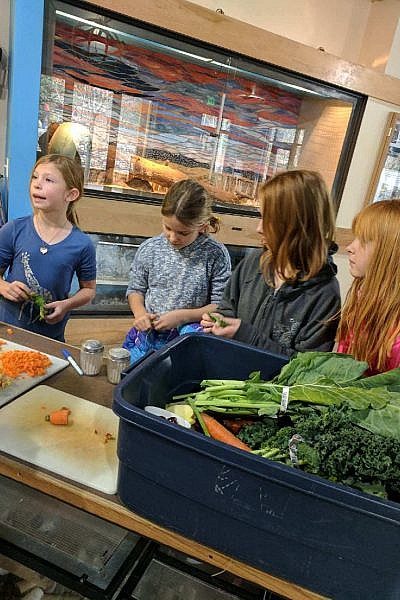

If you’re looking for fun and educational activities for the kids the Monday, Tuesday and Wednesday of Thanksgiving week, look no further than Cheyenne Mountain Zoo Fall Break Camps! Registration is open now.
On November 25, 26 and 27, 2019, kids from kindergarten to sixth grade can take part in one or all three days of available camps at the Zoo. Space is limited and pre-registration is required. Zoo member discount rates apply. Kindergarten half-day camps are from 9 a.m. to 1 p.m. each day and first through sixth grade camps are from 9 a.m. to 4 p.m. daily.
The Zoo also offers early morning and late afternoon one-hour extended camps to fit your busy schedule the Monday, Tuesday and Wednesday before Thanksgiving. Early Birds Camp is from 8 to 9 a.m. and Later Gators Camp is from 4 to 5 p.m.

Monday, Nov. 25, the camp theme is Hopping into Harvest. Join us as we all prepare for the cold months ahead. From growing long fur coats to stocking up on food, campers learn about how animals get ready to survive the winter.

Tuesday, Nov. 26, campers discuss the interesting varieties of family structures in the animal kingdom, with this day’s theme: FALLing for Family. Learn which animals are independent infants, which families stay together and what types of animal families lie somewhere in between.

Wednesday, Nov. 27, the theme is Happy ZOOgiving. Campers will help create special Thanksgiving enrichment items for the animals of Cheyenne Mountain Zoo. We’re thankful for our animals, and this is your child’s chance to help thank our animals by contributing to a unique Thanksgiving dinner.
Click here to find out more or to register.
Back to The Waterhole
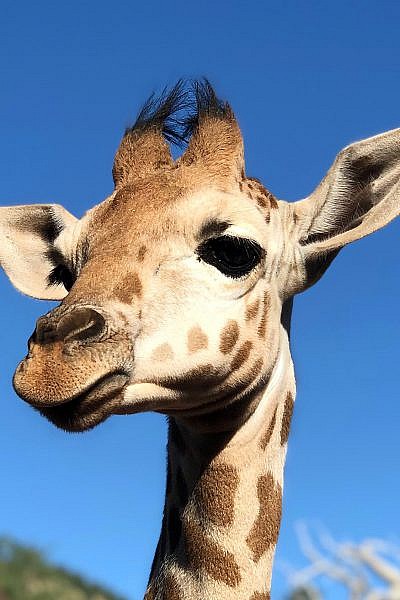

CMZoo year-round sponsor, Children’s Hospital Colorado, has created a guide to first-year doctor visits for human babies. Similarly, Cheyenne Mountain Zoo’s experience with our prolific giraffe breeding program, founded in 1954, gives us some great milestones for the first year of life for a giraffe calf. Let’s see how Viv, CMZoo’s giraffe calf born to Msitu in July 2019, compares to the average timelines.
The first day of a giraffe calf’s birth is full of important milestones. Within the first couple of hours after birth, the calf is expected to stand. It usually takes several very wobbly attempts before the calf is stable on those long legs. When calves are born, they drop about five feet from the birth canal to the floor. In human care, a birth stall usually has several inches of sand, hay or shavings on the ground to help cushion that fall. Once the calf has landed, it usually needs to ‘untangle’ its long legs and neck, and then can attempt to stand.
“Viv’s legs were wrapped up sort of like a pretzel when she landed, so it took her a few minutes to get them where they needed to be,” said Jason Bredahl, giraffe animal care manager. “Once she got those straightened out, she was the fastest calf we’ve ever seen take its first steps. She was up and walking within about 35 minutes of being born, and she really hasn’t slowed down since.”
Within the first three hours after birth, the calf is expected to nurse from its mother. It’s important for the calf to nurse within this window, because it ensures the newborn calf consumes the colostrum that contains important antibodies from its mother.
“Viv was on the slower side when it came to getting her first milk,” said Bredahl. “But, Msitu is a great mom, and she and Viv quickly bonded. Once they did, we saw her nursing a lot that first night and throughout the next few months.”
Normally, giraffe calves nurse for about four months without eating any solid foods, like leaves or grain. The average weaning period is anywhere from six months to a year. The baby usually starts investigating solid foods between two and three months of age.
Viv had other plans.
“We started noticing Viv nibbling on browse and being curious about crackers at about a month old,” said Bredahl. “She is still nursing, so she’s getting the nutrients she needs from mom, but at this point, her diet contains a lot of browse, alfalfa, grain and romaine lettuce from our guest feeding opportunities.”
Unless it’s medically necessary, CMZoo staff doesn’t intervene with animals’ births, and has found it’s beneficial to the mother/baby relationship to allow them uninterrupted time together to bond. Since Viv showed all the signs of being a strong calf, staff never took exact height or weight measurements.
On average, giraffe calves weigh between 100 and 200 pounds at birth, and measure about six feet tall.
“We guessed that she was about 200 pounds at birth and stood about six feet tall,” said Bredahl. “Since then, she’s growing and growing. As of the end of October, we estimate she’s about seven feet tall and over 300 pounds.”
The next big milestone for giraffe in care at CMZoo is to start training. Most giraffe calves born at CMZoo participate in behaviors, like shifting from one area to another, by following their mothers. This allows keepers to care for them by relying on training their mothers have received.

Not Viv.
“Viv has been a total firecracker from the very beginning, when she leap-frogged over her mom’s back as her mom was lying down only six hours after she was born,” said Bredahl. “She’s one of the most independent giraffe calves we’ve ever experienced, which is fantastic because she’s such a great ambassador for her species. She’s interested in guests, keepers and the rest of the herd. It also means she’s not necessarily interested in doing what her mom is doing. That makes shifting into the barn from the yard, or vice versa, or moving from one part of the barn to another an ‘adventure’ each day.”
Keepers rely on a calf’s interest in solid foods to train. The food is the positive reinforcement keepers need to encourage positive behaviors from an animal.
“In our experience, we usually start working with calves on trained behaviors at about four months,” said Bredahl. “Viv was a lot younger than that.”
Because Viv took interest in browse, alfalfa and other solid foods at such an early age, keepers started training with her at just a month old.
Keepers will continue working with Viv on her training, which is still largely focused on asking her to move from one location to another. Once she has mastered shifting behaviors, Viv will eventually graduate to more complicated training activities. Like her herd mates do now, she will later have the choice to participate in varieties of training that allow her to participate in her own health care.
“Our giraffe train to have their hooves trimmed and cared for, their blood drawn, their eyes examined, and of course they train to shift in and out of different areas of their yards and barn,” said Bredahl. “Khalid, our breeding bull, even trains to participate in giraffe ‘yoga,’ which helps him stretch and stay limber. Our giraffe training programs help us take great care of our herd. It also allows us to share what we learn and participate in research studies that benefit giraffe in human care and in the wild, around the world.”
(Try to) keep up with Viv and the 16-member CMZoo giraffe herd every day of the week in African Rift Valley at Cheyenne Mountain Zoo. No matter the weather, giraffe feeding opportunities are available to guests daily from 9 a.m. to 4 p.m., either on the outdoor boardwalk or inside the giraffe barn.
Back to The Waterhole
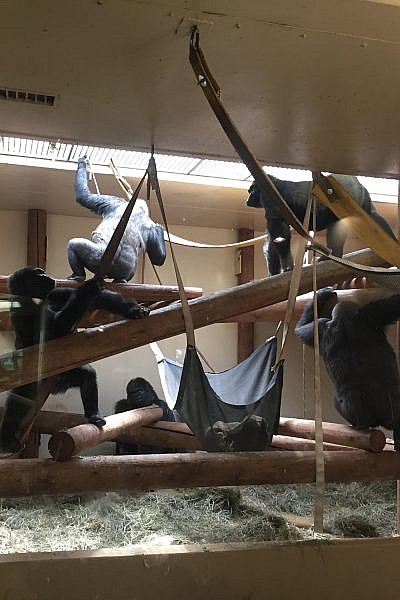

Cheyenne Mountain Zoo’s Western lowland gorilla troop of five has been working to acclimate to a cohesive living situation since Goma, a 28-year-old silverback, joined CMZoo in May 2016. After years of introductions that have taken longer than keepers anticipated, the tentative success of this summer’s introductions was critical in deciding whether to continue making efforts or to reassess if Goma could ever permanently join the troop.
“We had heard of successful introductions taking longer, but we had also accepted that there is a point at which, if Goma hadn’t adjusted to living with females, we would have to make a decision about whether we’d continue trying,” said Joanna Husby, Primate World animal care manager. “Just in the last three months, we have seen such amazing progress. It’s really rewarding to see them getting more comfortable with each other, which was our goal for this summer.”
The troop’s bonding progress was even more evident when they had to face the unexpected absence of Roxie – one of the two females Goma is most comfortable with in the group, along with Asha. The 43-year-old female became lethargic and refused to eat or drink in early October 2019.
“If Roxie feels under the weather, she’ll skip a meal, just like any of us might. But we know Roxie, and we realized her behavior this time was different,” said Husby. “After a couple of days, we knew we needed to take more aggressive steps to care for her.”
CMZoo veterinary team and keepers immobilized Roxie the morning of October 6. At the CMZoo vet clinic, Roxie’s examination included whole body x-rays and ultrasounds. She was given IV fluids and supportive medications that helped address any infection that may have been present. The examinations revealed multiple medical conditions, the most concerning of which was a suspected infection of Roxie’s reproductive tract. Throughout her life, Roxie has dealt with kidney issues and ulcer-like cysts that have caused gastrointestinal and reproductive system complications. The exam also revealed age-related changes such as arthritis.
While she was under anesthesia, Roxie suffered a cardiac arrest and was brought back to life with CPR and emergency drugs. Vet staff kept Roxie at the clinic, where they could respond immediately if necessary, for a few hours. When Roxie was stable, she returned to a private room near the troop to recover.

“Roxie has amazed us all,” said Husby. “She really scared us for a second, but she has recovered incredibly well. Within hours of returning to her den, she ate some grapes and drank some juice, which was a big relief.”
Keepers and vet staff checked on Roxie hourly overnight for the first night. The day following the procedure, Roxie was interested in training with her keepers, but she again refused food and drinks. Over the next few days, thanks to keepers’ creative solutions to hydrate Roxie by offering her different juices and foods that interested her, Roxie was able to rejoin the troop and is doing well.
Gorillas are incredibly intelligent and bonded individuals. Although Roxie’s absence could have been detrimental to the progress of the introductions, they have reunited well and continue to make progress.
“The fact that they were separated for about two weeks, during the scare and her recovery, and then had an uneventful reunion speaks to the resilience of their relationship. The female troop members are showing Goma respect by responding calmly to his presence and by following his lead upon moving to different areas of the exhibit,” said Husby. “Goma is still displaying signs of dominance, which is what we want to see. The ladies need to respect him. He’s also showing signs that he’s more comfortable, like lying down near the females and even taking naps. He’s learning that through his calmer demeanor and approach, he’s earning their trust as a leader.”
Summertime in Colorado is the optimal time to work on delicate gorilla introductions, because warmer weather means the gorillas have access to both indoor and outdoor spaces. They have more space to be together, if they want to be, while still having options to be away from each other.
For now, the troop is spending multiple hours per day together. As the weather cools down, and the gorillas don’t have as much access to their outdoor yards, keepers will work to continue providing a balance of time together and time apart for the troop.
“We’re so proud of the ladies and Goma for how much progress they’ve made this summer, even with the potential setback,” said Husby. “We’re looking for ways to continue that progress without regular use of the outdoor yards. Although the procedure with Roxie was very scary, it showed us that they’ve reached a level of comfort and confidence with each other that we hope will continue through the winter months.”
Keepers and vet staff continue to monitor Roxie’s health. We will provide updates as they are available.
Back to The Waterhole
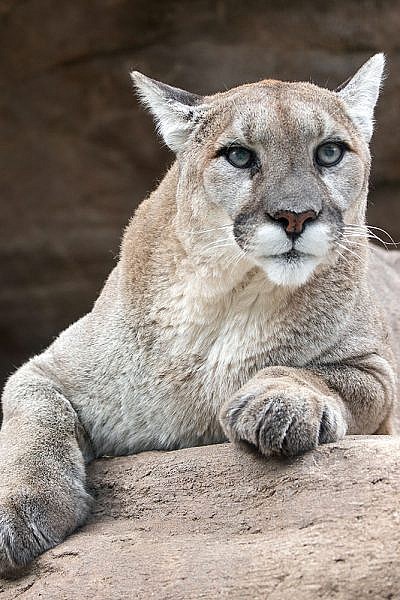

Colorado Springs, Colo. – Cheyenne Mountain Zoo is mourning the loss of Kaya, a 13-year-old mountain lion who lived a long life at CMZoo after being orphaned in the wild in Wyoming in 2006. This summer, she again captured the hearts of guests when she earned the nickname ‘Grandma Kaya’ by embracing the presence of three young kittens who were also orphaned in the wild and came to live at CMZoo.
Kaya’s passing comes in the midst of a difficult week, medically, for several beloved animals at the Zoo. In the past several days, urgent or emergency procedures have been conducted not only on Kaya, but also on Roxie, our oldest Western lowland gorilla at age 43, and on Zwena, one of our two oldest African lion sisters at age 12. The team is cautiously optimistic about both Roxie and Zwena, although further complications are possible for both animals.
Kaya, who would have turned 14 in November, passed away overnight in her den. After a sudden change in her energy level late last week, Kaya then refused to eat or take medications, even her favorite treats: goat’s milk and fish. On Saturday morning, veterinary staff performed an emergency examination to try to pinpoint the issue and treat it.
During the examination, Kaya didn’t show any specific issues, so she was treated for potential dehydration and given medication to make her more comfortable. Following the treatment at the CMZoo vet clinic, Kaya appeared to have recovered well without any complications and returned to her den to rest. Sunday morning, keepers found that despite the team’s best efforts, Kaya had passed overnight.
Kaya was blind and had ongoing age-related arthritis. A recent blood draw showed signs of early kidney disease, which isn’t unusual for a cat of her age. She is believed to have passed of natural causes and general age-related issues.
Mountain lions are usually solitary in the wild, but Kaya and her brothers lived together for their entire lives. Kaya was the last remaining sibling. Yuma died in July 2016, Motega passed in February 2019, and CMZoo lost Tocho in April 2019. After Tocho’s passing, keepers and guests had questions about whether Kaya would do well in the mountainous three-yard mountain lion habitat without her brothers and the company they’d always provided.
Just one month later, CMZoo received a call from the mountain lion Species Survival Program (SSP). Three six-week-old mountain lion kittens had been found orphaned in Washington State and needed a home right away. Although for bittersweet reasons, CMZoo had room to take them.
“At that point, our focus was on providing a home for these kittens and on creating an environment where Kaya had the option to enjoy having mountain lion company again,” said Rebecca Zwicker, Rocky Mountain Wild animal care manager who worked with Kaya and her siblings for over ten years. “It was also an opportunity for these kittens to have an adult female mountain lion around, to be there with them in those tender first months when they were moving into this strange new world. Kaya really showed them the ropes of the exhibit.”
Zwicker recalls talking with her fellow Rocky Mountain Wild keepers about how the kittens — females Adira and Sequoia, and male Sitka — were learning from Kaya. They learned to explore the exhibit, where to find the best sunny nap spots, and how to approach Kaya.
“Their introduction went smoothly, but it wasn’t like they raced into each other’s paws,” said Zwicker. “The whole time we were planning their introductions we kept in mind that Kaya is blind, older, much bigger and a bit slower. Thirteen-year-old Kaya had to set some ground rules with these rambunctious kittens.”
After vocal warnings and a few light physical corrections from Kaya, the kittens learned it wasn’t in their best interest to surprise their blind cohabitant. Keepers noticed the kittens would approach her more slowly and with plenty of ‘chirps’ to let Kaya know they were coming. Once Kaya seemed to accept their presence, though, she would lie nearby while the kittens wrestled each other, and sometimes even got in on the fun.
Kaya was often seen navigating the rocky habitat, closely trailed by the kittens, and cuddling with them in the same sunny spot where she used to cuddle with her brothers. One day, keepers noticed Kaya had some wet, matted fur patches on her sides, legs and shoulders. They weren’t sure what was causing it, but then realized the kittens had been grooming Kaya. Grooming is often considered a sign that animals are comfortable around each other, and in some species is seen as a bonding activity.
“When Kaya accepted those kittens, those of us who had been working on the introductions knew it was just magic,” said Zwicker. “Kaya’s story is so powerful because it’s full-circle. We’ve seen her step into this world with her brothers as a young, unsure, orphaned kitten. We’ve seen her develop relationships with her keepers and grow up into a rock star trainee. We’ve seen her tenacity through the hardship of losing her eyesight. We’ve seen her lose her brothers one-by-one and witnessed her perseverance to continue training and stay engaged during the weeks she was alone in the habitat. To see her become ‘Grandma Kaya’ in her final months was like she’d completed the cycle. Those kittens were comfortable with her, and Kaya was an important piece of their world. She’s passed the torch, in a way. I just wish they – and we – could have had her a little longer.”
Keepers will closely monitor Sequoia, Adira and Sitka, who have returned to their normal behaviors. Keepers gave the kittens access to Kaya after she passed, so they had the opportunity to find closure.
“Sitka went into Kaya’s den and slowly approached her, sniffed her, gave her a chuff (a cat greeting), then chirped and lied down next to her,” said Zwicker. “After a few minutes, he went back outside to find his sisters, who were climbing up a branch against the glass viewing area, being their normal crazy selves. Things will be different for them without Kaya, but they have us and each other, so they’ll be okay.”
Having the young kittens inspires keepers to continue serving Kaya’s species and her legacy through this next generation of CMZoo mountain lions.
It’s the end of an era for Rocky Mountain Wild. As CMZoo says goodbye to the last of the first orphaned siblings, it’s heartwarming to know that the next generation of kittens had the chance to benefit from Kaya’s presence, and that they provided Kaya with cuddles, playtime and company during her final months.
About Cheyenne Mountain Zoo
Cheyenne Mountain Zoological Society was founded in 1926. Today, Cheyenne Mountain Zoo, America’s mountain Zoo, offers comprehensive education programs, exciting conservation efforts and truly fantastic animal experiences. In 2019, Cheyenne Mountain Zoo was voted #6 Best Zoo in North America and CMZoo’s Rocky Mountain Wild was named #5 Best Zoo Exhibit in North America by USA TODAY 10Best Readers’ Choice Awards. It is Cheyenne Mountain Zoo’s goal to help guests fall in love with animals and nature, and take action to protect them. Of the 233 zoos and aquariums accredited by the Association of Zoos and Aquariums (AZA), Cheyenne Mountain Zoo is one of just ten operating without tax support. Cheyenne Mountain Zoo depends on admissions, membership dues, special event attendance and donations for funding.
Tickets are on sale now for seven nights of spooktacular activities over two weekends and Halloween night
Colorado Springs, Colo. – Cheyenne Mountain Zoo will feel the Halloween spirit when thousands of little ghouls and goblins attend Boo at the Zoo beginning Friday, Oct. 18, 2019. The event is a fun way for families to trick-or-treat and enjoy Halloween festivities in a safe and unique environment. This year’s Boo at the Zoo is Oct. 18 – 20, 25 – 27 and 31. Boo hours are 4 to 8:30 p.m. all seven nights, with the last admission at 7:30 p.m. Cheyenne Mountain Zoo admission windows will close for daytime admission at 2 p.m.
Frightfully fun attractions include a Lighted Pumpkin Patch with 60 jack-o-lanterns, a 2,000 sq. ft. Haunted House, Ghoulish Graveyard and Pirate Cove. Attendees can also enjoy rides on the carousel and Sky Ride. The Sky Ride will be open as weather allows, providing a breathtaking view of Colorado Springs at night and a lift to two additional trick-or-treat stations at the top.
Of course, a visit to the Zoo wouldn’t be complete without animals! Special keeper talks, animal demos and animal encounters will be offered each night. Select animal exhibits will also be open, including giraffe, lions, Goat Experience, Scutes Family Gallery, Wilgruen Elephant Barn, The Loft, Monkey Pavilion and Australia Walkabout. Beginning at 4:15 p.m. each night of Boo at the Zoo, attendees can interact with small animals at Safari Cabin, where a new animal will make an appearance every 45 minutes.
An elephant-sized amount of candy (more than 9,000 pounds) will be handed out at more than 25 trick-or-treat stations throughout the Zoo during Boo at the Zoo. The Zoo’s candy supply is purchased from companies that are members of the Roundtable on Sustainable Palm Oil (RSPO), which is committed to the use of sustainable palm oil and the protection of orangutan habitat in the wild. To find your own Halloween candy that’s orangutan friendly, download CMZ’s sustainable palm oil shopping guide at: www.cmzoo.org/palmoil.
Boo at the Zoo attendees are encouraged to purchase tickets online, in advance of the date they want to visit. The online price is $5 less per ticket than at the gate and CMZoo Members receive an additional $5 off each ticket. Popular evenings are likely to sell out! Tickets will be available for purchase at the gate only if not sold out in advance. Ticket prices increase at the gate. On-site parking is limited and is not guaranteed with advance ticket purchase. If the Zoo’s parking lot is full, follow the signs to our free off-site shuttle parking lot. Purchase tickets online, refer to costume requirements, check animal demonstration schedules and more at: cmzoo.org/boo.
Fast Facts
Boo at the Zoo at Cheyenne Mountain Zoo
Dates: Oct. 18 – 20, Oct. 25 – 27 and Oct. 31, 2019
4 to 8:30 p.m. (last admission at 7:30 p.m.)
Boo Online Advance Pricing:
$19.75 for ages 3-64
$14.75 for Zoo members
$17.75 Military and 65+
75¢ for ages 2 and under
Boo Gate Pricing (availability not guaranteed):
$24.75 for ages 3-64
$19.75 for Zoo members
$22.75 Military and 65+
75¢ for ages 2 and under
For more information and to purchase tickets, visit cmzoo.org/boo.
Boo at the Zoo is possible thanks to our generous sponsors, Children’s Hospital Colorado, Colorado Springs Pediatric Dentistry, Les Schwab Tire Centers, Raising Cane’s Chicken Fingers, T. Rowe Price and your Colorado Springs Toyota dealers, Larry H. Miller Toyota Colorado Springs and Larry H. Miller Liberty Toyota Colorado Springs.
About Cheyenne Mountain Zoo
Cheyenne Mountain Zoological Society was founded in 1926. Today, Cheyenne Mountain Zoo, America’s mountain Zoo, offers comprehensive education programs, exciting conservation efforts and truly fantastic animal experiences. In 2019, Cheyenne Mountain Zoo was voted #6 Best Zoo in North America and CMZoo’s Rocky Mountain Wild was named #5 Best Zoo Exhibit in North America by USA TODAY 10Best Readers’ Choice Awards. It is Cheyenne Mountain Zoo’s goal to help guests fall in love with animals and nature, and take action to protect them. Of the 233 zoos and aquariums accredited by the Association of Zoos and Aquariums (AZA), Cheyenne Mountain Zoo is one of just ten operating without tax support. Cheyenne Mountain Zoo depends on admissions, membership dues, special event attendance and donations for funding.
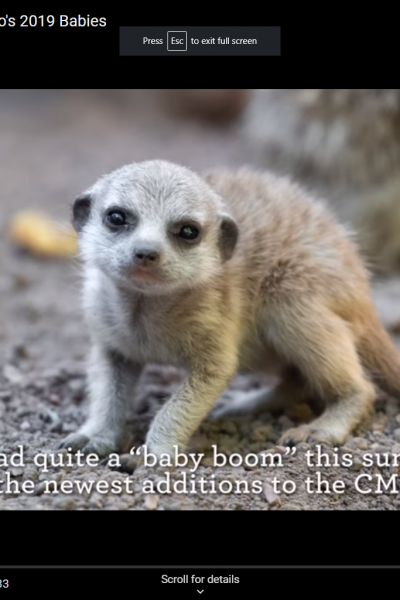

We had a baby boom in 2019! From meerkat pups to mountain lion kittens to a giraffe calf and more, the seven species of babies are growing up fast. (Make sure you watch until the end to meet our latest addition: five meerkat pups!)
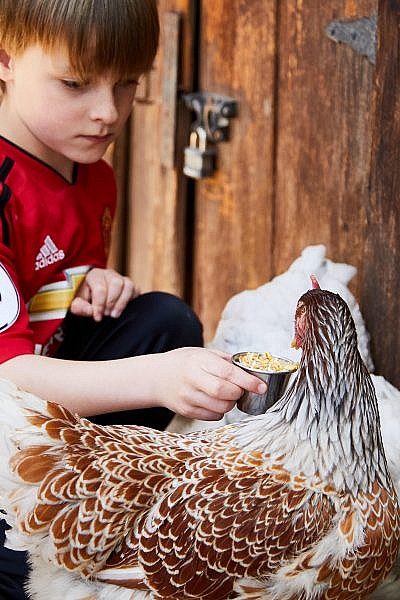

Some people are surprised to learn that seventeen chickens live in Cheyenne Mountain Zoo’s My Big Backyard, where guests can also meet rabbits, koi fish, amphibians, insects, our honeybee colony, tarantulas, and more. The chickens are each named after famous chefs or tasty spices and all have unique personalities to match.
It’s not unusual to hear cooing chickens and guests giggling with delight, as they get the opportunity to meet these unique species of chicken up close and personal. Guests can interact with them during their daily “Chicken Parades,” when they run down the road from their chicken coop to their pen in My Big Backyard. Guests who would like to get even closer have the chance to do so for $1 during the chicken feeding experience. These interactions are available all day every day, when the weather is warm enough for these hearty chickens to be outside.
When they’re not on parade or connecting with guests, the chickens are training with their keepers. Here are a few fan favorites, and their current training efforts, to look for next time you visit My Big Backyard:

Rosemary is the flock’s only White Crested Black Polish chicken. Her fabulous frock of white feathers on the top of her head makes her easy to recognize. She may not be able to see very well because of the sheer volume of her feathery headdress, but she has phenomenal hearing and recognizes her lead trainer’s voice out of any crowd. Rosemary is trained to peck at a target, to jump onto hands and to turn around in a circle. People love Rosemary because of her funny head of feathers and her calm and outgoing demeanor. Rosemary is often one of the first chickens to attend off grounds ZOOMobile programs, as she doesn’t mind new surroundings as long as there is good food.

Martha Stewart is the CMZoo flock’s only Lakenvelder chicken. She has black feathers on her neck and tail, but her body feathers are white. Martha is a very eager eater, and you may see her running towards guests with food cups, or stealing tasty bugs from other chickens. Martha is learning how to tell the difference between colors. She is learning station training and target training. Keepers show Martha a blue paddle or a red paddle, and she walks to stand on a circle that is the same color as the paddle her keepers present. Most of the time Martha gets it right, but sometimes she gets really excited about her meal worm treats and forgets about the colors. Martha is also learning to go on ZOOMobile programs.

Guy Fieri is the newest addition to our chicken family. He is an Araucana rooster and lives in a side yard with Laredo, a Rio Grande turkey. Guy is a very “talkative” rooster. If you wait by his yard for a few minutes, you are almost guaranteed to hear him crow. Guy is settling in to the chicken family, approaching keepers and discovering which foods are his favorite. Guy is very mild mannered and spends his days exploring the yard and finding new areas to perch.
All the chickens in My Big Backyard have the option of staying in the yard and interacting with guests, taking a break in the side yard to just relax or maybe lay an egg, or flying out and exploring the Zoo on their own. If you see a chicken outside of the yard or coop, don’t worry. They are just exploring their spaces and looking for bugs to eat. They always come home to roost in their coop at night.
